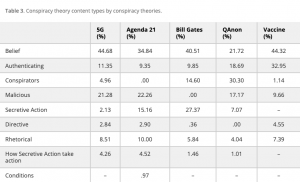Research analyzes spread of COVID-19’s most common early conspiracies

Research analyzes spread of COVID-19’s most common early conspiracies
The early stages of the pandemic created a breeding ground for COVID-19 conspiracy theories, which, on Twitter, spread almost as fast as the virus itself. But out of the pandemic’s most prominent early conspiracies, which were shared the most and why?
To find out, a team of researchers, led by Itai Himelboim, the Thomas C. Dowden Professor of Media Analytics at the University of Georgia’s Grady College of Journalism and Mass Communication, collected nearly 400,000 tweets sent between Jan. 19, 2020, to June 30, 2020, about COVID-19 conspiracy theories surrounding Bill Gates, QAnon, the vaccine, 5G networks and Agenda 21. They then analyzed the content of the webpages shared in the tweets.
The most tweeted about COVID-19 conspiracy theories
The overwhelming majority, roughly 87 percent, of webpages linked in tweets and retweets centered on the conspiracy theory surrounding Bill Gates, a villain-based conspiracy theory blaming Gates for creating the virus and financially benefiting from the pandemic. Following Gates, in order of most to least tweeted about, were QAnon, 5G networks, the vaccine and Agenda 21.
“Looking for who to blame for the pandemic was a major motivator in the early stages of the pandemic-related conspiracy theories, illustrated by the Bill Gates-related theory being the most popular,” Himelboim explained.

Not only were the Bill Gates-related conspiracy theory webpages the most popular in terms of being shared on Twitter, but there were also the most of them. Tweets related to the Bill Gates conspiracy linked back to 144 different webpages, while there were only 67 unique webpages associated with the conspiracy claiming 5G networks contributed to the pandemic and 79 unique webpages associated with conspiracies surrounding the vaccine, for example.
“I was surprised by the prevalence of COVID-19 vaccination in conspiracy theories,” Himelboim explained. “In the first six months of the pandemic in the United States, which is what the study focused on, not only were vaccines not available, but they were also only in the very early stages of development.”
Persuasion strategies used to support the conspiracies
The researchers also sought to understand the different types of content, or persuasion strategies, being used to support each conspiracy theory. Overall, the majority of sources were sharing information that simply implied the theories were true. Although, more established conspiracy theories, such as those involving Agenda 21 and QAnon, focused less on supporting “belief” than some of the newer or lesser-known conspiracies.
For example, just above 22 percent of the sources related to the Agenda 21 conspiracy, which claims that the United Nations and governments around the world are colluding to wipe out 90 percent of the global population, feature content highlighting the malicious purposes of those claimed to be behind the COVID-19 virus. Likewise, the majority, roughly 30 percent, of COVID-19 conspiracy theory webpages related to QAnon featured content that zeroed in on who the specific conspirators are.

Understanding the makeup of different conspiracy theories and what type of content is more likely to resonate can be very helpful when addressing such theories, explained Himelboim. However, the researchers found few examples of specific types of content predicting higher engagement, such as retweets.
Only content explaining the “malicious purposes” behind a specific conspiracy, such as suggesting conspirators are making money off of the virus, and content highlighting the “secretive actions” the conspirators take were directly correlated with predicting higher engagement.
The co-authors of the paper, titled “What do 5G networks, Bill Gates, Agenda 21, and QAnon have in common? Sources, distribution, and characteristics,” include Jeonghyun (Janice) Lee, a Ph.D. student at Grady College, Porismita Borah, an associate professor in Washington State University’s Murrow College of Communication, Danielle Ka Lai Lee, a Ph.D. student at Murrow College, Yan Su, an assistant professor in the School of Journalism & Communication at Peking University, China, Anastasia Vishnevskaya, a Ph.D. student at Murrow College, and Xizhu Xiao, a Ph.D. student at Murrow College.